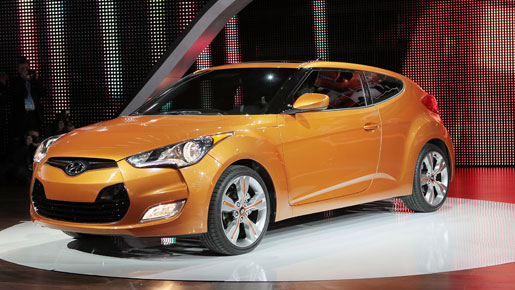
Hyundai’s i30 has been a strong success story since it was launched last year. Thanks to a combination of strong dynamic driving qualities, cutting-edge styling – the car’s styling is regularly compared to a BMW 1-Series in the motoring press – and with generous standard equipment, the i30 was rapidly wreathed in accolades and awards. It’s also been about peace of mind for many consumers; few new cars have a three year warranty as standard. Crucially, these factors have translated into a solid sales success story – so far. “Our latest sales are very good,” says Paolo Bossi. “Up to August we’d sold more than 45,000 i30s. The 1.6 turbo diesel model has proved especially popular. More than 15,000 cars have gone to the non-private market (fleet and rental market), which is more than we were aiming for – more than 30 percent of overall sales. That means the i30 is now being seen as a real alternative to a VW Golf or a Ford Focus. Each customer is therefore a new customer for us. And we’re completely delighted.”
That may be well and good, but South Korean cars attempting to break into the tough European car market have often ended up trading sales at deep discounts. How much, then, has Hyundai been discounting its model range this year? “The sales approach depends on the country. But what we’ve been emphasising with this car, regardless of where it is sold, is the quality of construction and design, and how well specified it is. If you get that right then you don’t need to discount heavily.”
Of course, the only way to keep success going is to build on it. In Hyundai’s case, a rash of new models are on the way: a CO2-busting environmentally-friendly compact i20 model and the ix:55, a new luxury SUV (admittedly, a seemingly contradictory approach though one that has a clear strategy, as will be explained). Their future success will depend on successful pricing, but Bossi thinks they’ll get the balance right. It’s not just about pricing per se. Tax-efficient pricing is becoming increasingly significant as governments encourage consumers to buy cars that emit fewer emissions. Hyundai’s i20, its replacement for its Getz Super compact, is probably the more significant release in this respect. With its distinctive tear-shaped headlights, the i20 will be a fair bit larger inside than the Getz. The I20’s CO2 credentials will make an impact, particularly with the planned i-20 blue model says Bossi; emissions are thought to come under the psychologically critical 120g/km threshold thanks to low-rolling resistance tyres and special aero-resistance tweaks. “The i20 will do well in certain parts of Europe where environmental tax concessions make such cars increasingly popular.
Emissions interest is very strong now in France and the Nordic countries, so we are changing our proposals for those markets. But the i30, don’t forget, also has very good emissions credentials.”
With a wider, more focused model range en route, Hyundai meanwhile has time to prepare a comprehensive assault on larger European fleets. “We do want to compete in that space,” says Bossi, “however, at the moment we are competing with medium and smaller vehicles – customers and dealer sales. That’s historical territory for us. But it does mean that we are preparing the ground for a higher share of bigger tenders in the next two years.”
Part of that groundwork preparation is obvious in Hyundai’s new stock locator strategy, supported by a tie-up with partner Mannheim, which is professionalising its dealer network. “Our stock locator technology helps us to reduce rationalise sales and provide us with up-to-the-minute information on all stock. It’s a vital part of upgrading that network.” That’s also evident in around 28 countries where Hyundai now has a fleet team to manage the issues of buy-back, maintenance and insurance.
Despite the i30’s obvious success, Hyundai still needs presence in the upper end of the market; no eco-super-compact or Golf rival, however impressive and competent, can do that. That is the job of Hyundai’s new SUV, tagged ix55 (sold as the Vera Cruz in the US). Although 4x4s are falling in popularity in both Europe and the US because of high fuel prices and concerns over heavy CO2 emissions, but as brand boosters they’re impossible to ignore. “We’ve already launched this car in the domestic and the US-market. Of course, we’re not expecting serious volumes as it’s not that type of car. But the ix 55 will position Hyundai right at the top end along with Mercedes and BMW. It’s a top quality 4×4 and will really up level Hyundai’s image. That’s important.” Meanwhile, Hyundai’s other 4×4, the Santa Fe, will receive a minor model change in 2009. Also, for the first time, Hyundai is about to enter the growing hybrid market with an adapted petrol-electric Hyundai Sonata. This car will run with the help of new-generation lithium-polymer batteries. However, it is likely Hyundai may keep the Sonata hybrid away from Europe in laying the ground for its successor, the i40, a new family-sized model which, if the i30 is anything to go by, is likely to be radically different to its predecessor.
Although unwelcome, the credit crunch meanwhile continues to make life difficult for many car makers. But Hyundai’s new-found design confidence and traditional strengths of value for money should mean it weathers the current credit crunch better than other car manufacturers. Fleet managers also are slowly realising that a combination of highly competitive pricing and showroom appeal – something Asian cars often lacked in the past – is bolstering Hyundai residuals. On an overall pence per mile basis, they look increasingly sensible. “Across the board, our cars are considered excellent value for money, so we’re not losing too many sales. People are choosing Hyundai not just for good value for money but for high quality as well. Some brands are clearly struggling while we’re looking very stable.”

